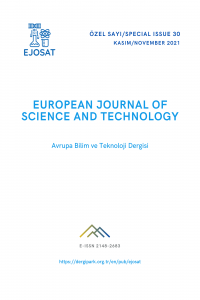Proteus ve MATLAB Simulink Yazılımı Kullanılarak Bağımsız Solar Fotovoltaik İnverterin Karşılaştırmalı Değerlendirilmesi
Abstract
Artan küresel enerji talebinin büyük bir kısmı şu anda kömür, doğal gaz ve fosil yakıtlar gibi konvansiyonel enerji kaynaklarına bağımlıdır. Ancak konvansiyonel enerji kaynakları zamanla tükenmekte ve bu kaynakların fiyatları da artmaktadır. Bu nedenle, güneş PV, rüzgar çiftlikleri, biyodizel ve biyogaz vb. dahil olmak üzere yenilenebilir enerjinin yaygınlaştırılması, modern elektrik şirketlerinin ihtiyacıdır. Yenilenebilir enerji kaynakları arasında güneş enerjisi en bol bulunan, coğrafi olarak en zengin, temiz ve gürültüsüz enerji kaynağıdır. Güneş enerjisinin çeşitli avantajlarına rağmen, güneş panelinin nispeten düşük verimliliği ve elektronik dönüşüm kayıpları, uygulamalarını sınırlandırmaktadır. Bu nedenle, bu makalede güneş PV sistemi için daha yüksek verimliliğe sahip sinüzoidal darbe genişlik modülasyonu tabanlı tam köprü DC-AC evirici tasarlamıştır. Doğruluğu artırmak için simülasyon Proteus ve Simulink MATLAB yazılımlarında gerçekleştirilmiştir. Simülasyon sonuçları ile inverterin doğruluğu ve verimliliği karşılaştırılmıştır.
References
- Alhafadhi, Liqaa, and Jiashen Teh. 2020. “Advances in Reduction of Total Harmonic Distortion in Solar Photovoltaic Systems: A Literature Review.” International Journal of Energy Research 44(4):2455–70.
- Converters, A. C. n.d. “Lesson Introduction to Voltage Source Inverters.” 1–14.
- Kumar, Raj, S. K. Singh, and others. 2018. “Solar Photovoltaic Modeling and Simulation: As a Renewable Energy Solution.” Energy Reports 4:701–12.
- Li, Dexin, and Pai H. Chou. 2004. “Maximizing Efficiency of Solar-Powered Systems by Load Matching.” Pp. 162–67 in Proceedings of the 2004 International Symposium on Low Power Electronics and Design (IEEE Cat. No. 04TH8758).
- Mousazadeh, Hossein, Alireza Keyhani, Arzhang Javadi, Hossein Mobli, Karen Abrinia, and Ahmad Sharifi. 2009. “A Review of Principle and Sun-Tracking Methods for Maximizing Solar Systems Output.” Renewable and Sustainable Energy Reviews 13(8):1800–1818.
- Sastry, Jyoti, Panagiotis Bakas, Hongrae Kim, Lei Wang, and Antonios Marinopoulos. 2014. “Evaluation of Cascaded H-Bridge Inverter for Utility-Scale Photovoltaic Systems.” Renewable Energy 69:208–18.
- System, Power. 2016. “An Intelligent MPPT Design of DC-DC Converter for PV in a PV / SC Hybrid 290 . An Intelligent MPPT Design of DC-DC Converter for PV in a PV / SC Hybrid Power System.” (November).
- Taherbaneh, Mohsen, A. H. Rezaie, H. Ghafoorifard, K. Rahimi, and M. B. Menhaj. 2010. “Maximizing Output Power of a Solar Panel via Combination of Sun Tracking and Maximum Power Point Tracking by Fuzzy Controllers.” International Journal of Photoenergy 2010.
- Younas, Umair. 2019. “Nevşehir Bilim ve Teknoloji Dergisi The Implementation of Effective Modulation Schemes to Improve the Power and Harmonic.” 8:125–35. doi: 10.17100/nevbiltek.559465.
- Younas, Umair, Bayram Akdemir, and Ahmet Afsin Kulaksiz. n.d. “Modeling and Simulation of a Grid-Connected PV System under Varying Environmental Conditions.” International Journal of Energy Applications and Technologies 6(1):17–23.
- Zhong, Qing-Chang, and Tomas Hornik. 2012. Control of Power Inverters in Renewable Energy and Smart Grid Integration. Vol. 97. John Wiley & Sons.
Comparative Assessment of Standalone Solar Photovoltaic Inverter using Proteus and MATLAB Simulink Software
Abstract
Majority of the rising global energy demand is currently dependent on the conventional energy sources like coal, natural gas and fossil fuels etc. However, the conventional energy sources are depleting with time and the price of these sources is also increasing. Therefore, the deployment of renewable energy including solar PV, wind farms, biodiesel and biogas etc. are the need of the modern electric utility. Among renewables, the solar energy is the most abundant, geographically rich, clean, and noiseless energy source. Despite the various advantages of the solar energy, the lower efficiency of the solar panel and electronic conversion losses limits its applications. Therefore, this paper proposed the sinusoidal pulse width modulation based full bridge DC-AC inverter with higher efficiency is designed for the solar PV system. In order to enhance the accuracy, the simulation is performed in Proteus and Simulink MATLAB software. The accuracy and efficiency of the inverter is compared through the simulation results.
References
- Alhafadhi, Liqaa, and Jiashen Teh. 2020. “Advances in Reduction of Total Harmonic Distortion in Solar Photovoltaic Systems: A Literature Review.” International Journal of Energy Research 44(4):2455–70.
- Converters, A. C. n.d. “Lesson Introduction to Voltage Source Inverters.” 1–14.
- Kumar, Raj, S. K. Singh, and others. 2018. “Solar Photovoltaic Modeling and Simulation: As a Renewable Energy Solution.” Energy Reports 4:701–12.
- Li, Dexin, and Pai H. Chou. 2004. “Maximizing Efficiency of Solar-Powered Systems by Load Matching.” Pp. 162–67 in Proceedings of the 2004 International Symposium on Low Power Electronics and Design (IEEE Cat. No. 04TH8758).
- Mousazadeh, Hossein, Alireza Keyhani, Arzhang Javadi, Hossein Mobli, Karen Abrinia, and Ahmad Sharifi. 2009. “A Review of Principle and Sun-Tracking Methods for Maximizing Solar Systems Output.” Renewable and Sustainable Energy Reviews 13(8):1800–1818.
- Sastry, Jyoti, Panagiotis Bakas, Hongrae Kim, Lei Wang, and Antonios Marinopoulos. 2014. “Evaluation of Cascaded H-Bridge Inverter for Utility-Scale Photovoltaic Systems.” Renewable Energy 69:208–18.
- System, Power. 2016. “An Intelligent MPPT Design of DC-DC Converter for PV in a PV / SC Hybrid 290 . An Intelligent MPPT Design of DC-DC Converter for PV in a PV / SC Hybrid Power System.” (November).
- Taherbaneh, Mohsen, A. H. Rezaie, H. Ghafoorifard, K. Rahimi, and M. B. Menhaj. 2010. “Maximizing Output Power of a Solar Panel via Combination of Sun Tracking and Maximum Power Point Tracking by Fuzzy Controllers.” International Journal of Photoenergy 2010.
- Younas, Umair. 2019. “Nevşehir Bilim ve Teknoloji Dergisi The Implementation of Effective Modulation Schemes to Improve the Power and Harmonic.” 8:125–35. doi: 10.17100/nevbiltek.559465.
- Younas, Umair, Bayram Akdemir, and Ahmet Afsin Kulaksiz. n.d. “Modeling and Simulation of a Grid-Connected PV System under Varying Environmental Conditions.” International Journal of Energy Applications and Technologies 6(1):17–23.
- Zhong, Qing-Chang, and Tomas Hornik. 2012. Control of Power Inverters in Renewable Energy and Smart Grid Integration. Vol. 97. John Wiley & Sons.
Details
| Primary Language | English |
|---|---|
| Subjects | Engineering |
| Journal Section | Articles |
| Authors | |
| Publication Date | December 15, 2021 |
| Published in Issue | Year 2021 Issue: 30 |


